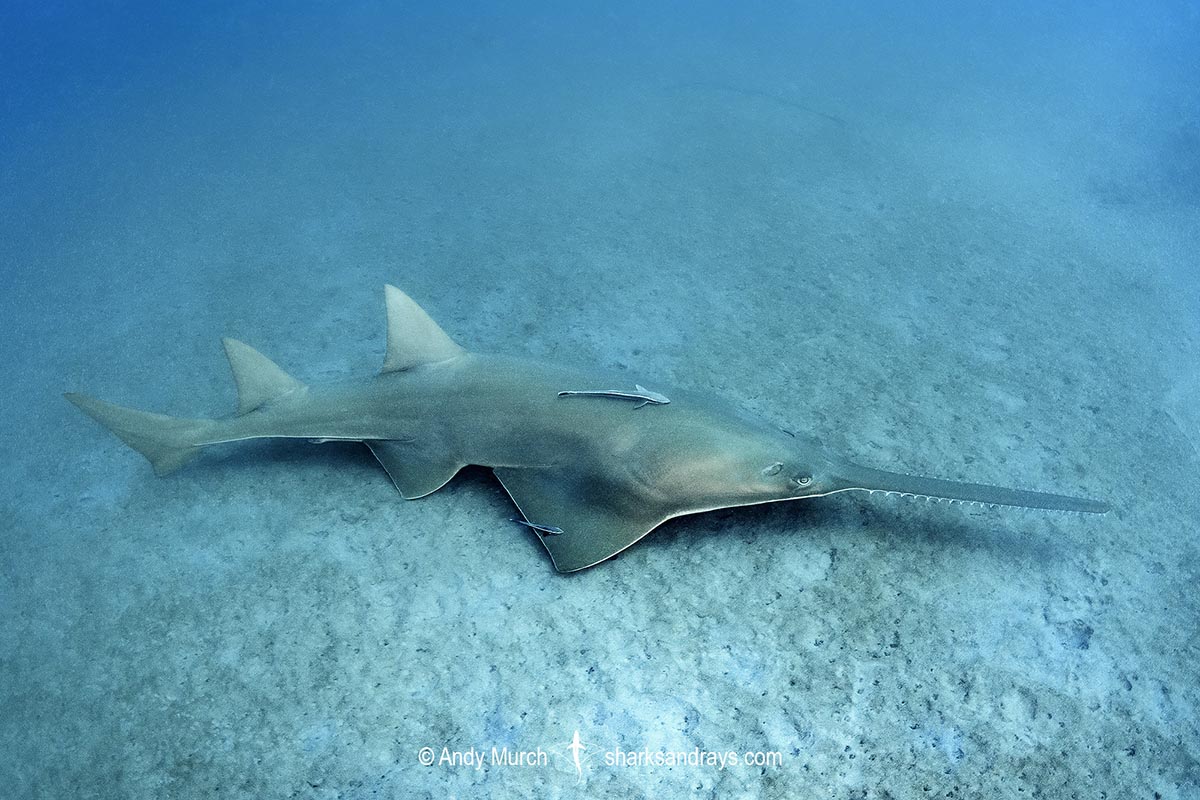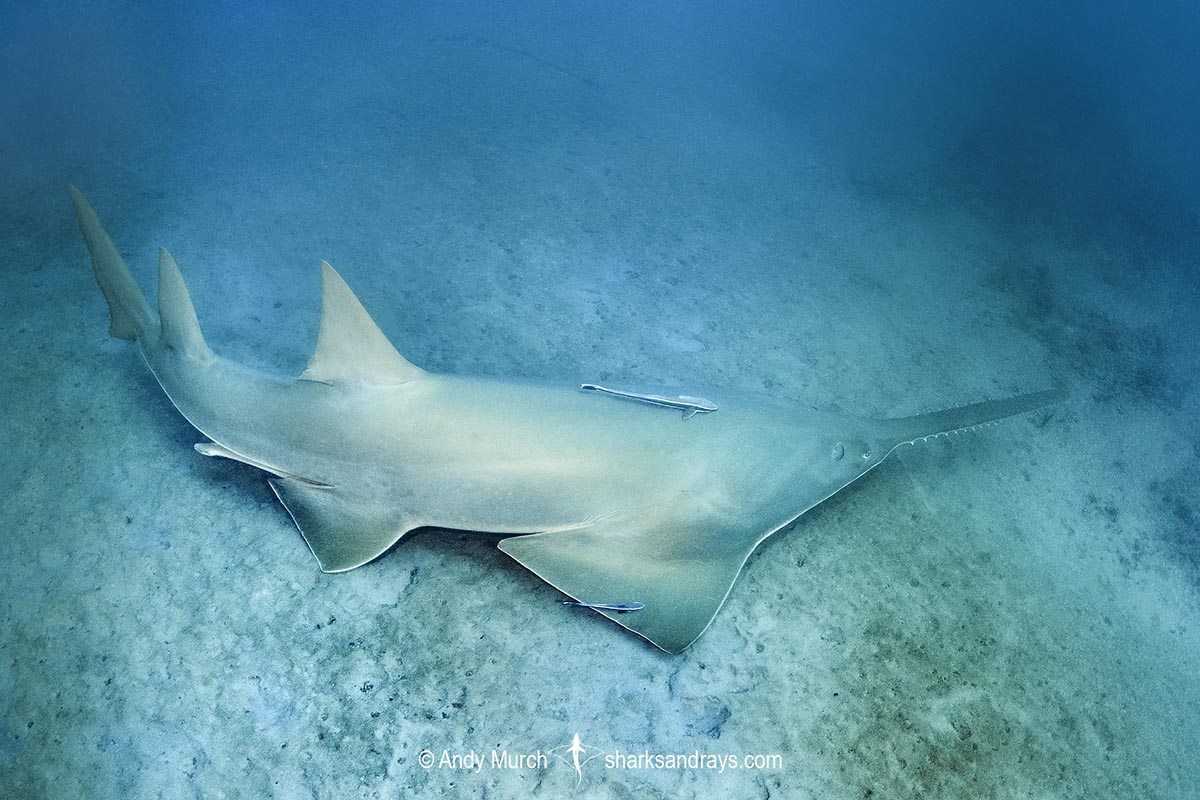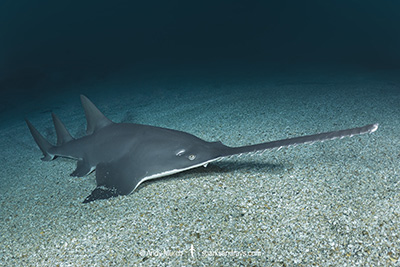Common names
Smalltooth Sawfish.
Binomial
Pristis pectinata.
Synonyms
Pristis acutirostris, Pristis annandalei, Pristis evermanni, Pristis granulosa, Pristis leptodon, Pristis megalodon, Pristis occa, Pristis pectinatus, Pristis serra, Pristis woermanni, Pristobatus occa.
Identification
A large, heavy-bodied sawfish. Entire body covered with rough denticles. Rostrum relatively narrow, with 20-30 paired rostral teeth. Teeth slightly closer together at rostral tip than base. Rostrum length 0.21-0.3 x total length. First dorsal fin origin level with, or slightly posterior to pelvic fin origins. Dorsal posterior margins straight. Pectoral fins narrow and long, anterior margins weakly convex, posterior margins straight, apices obtusely angular. Caudal fin posterior margin straight, without defined lower caudal lobe. Large lateral keel on caudal fin base.
Colour
Dorsum greyish-brown or bluish-grey. Ventrum White, Rostral teeth white.
Size
Maximum accepted length 554cm. Anecdotal reports to 760cm. Size at birth ~60cm.

Conservation Status
CRITICALLY ENDANGERED
The Smalltooth Sawfish (Pristis pectinata) is a bycatch component of many demersal fisheries, notably due to it’s rostrum which is easily entangled in nets and line. Historically, it was heavily targeted for its meat and the high quality of its fins. In many areas it is still retained even though international trade is illegal since its inclusion in CITES Appendix 1 in 2007.
Smalltooth sawfish populations are slowly recovering in the USA, the Bahamas, and parts of Mexico, but it continues to decline elsewhere and has been exterpated from much of its former range.

Habitat
Tropical/ Subtropical inshore habitats. The smalltooth sawfish is associated with mangrove and estuarine environments and nearshore sand and mud often adjacent to reef flats. Red mangrove (Rhizophora mangle) is considered a critical habitat for this species. 0.1-88m.
Distribution
Atlantic Ocean and possibly southeast Africa.
In the Americas, Smalltooth Sawfish were historically found as far south as Uruguay, throughout the Caribbean and Central America, within the Gulf of Mexico, and along the Atlantic coast of the United States to the Carolinas. However, smalltooth sawfish have been wholly or nearly extirpated from large areas of their former range. The species is currently known to occur in the southeastern United States, The Bahamas, Cuba, Honduras, and Belize.
In the eastern Atlantic, the status of the smalltooth sawfish appears to be even more dire. Historically present from Angola to Mauritania, there has been only one confirmed record for the region in the last 10 years (Sierra Leone in 2003). Two other unconfirmed reports exist but may be misidentifications of other species.
There are no recent records from East Africa. If historical catches were accurately identified, it has been completely extirpated from that region.
Reproduction
Aplacental lecithotrophic viviparous. Litter size 15-20.
Diet
Smalltooth sawfishes mostly feed on crabs and other benthic invertebrates.
Behavior
Juvenile smalltooth sawfish mostly inhabit shallow mangroves and inshore areas. Adults have larger home ranges and sometimes move offshore into deeper water.
Reaction to divers
Somewhat skittish. May allow a close approach with slow, non-threatening movements.
Diving logistics
Rarely encountered by divers due to their scarcity and preference for inshore turbid environments. However, after longterm conservation efforts that include education of fishermen and heavy fines for harming the species, sightings in Florida are on the rise.
There are still no reliable locations to find Smalltooth sawfish but snorkeling in red mangrove areas of Florida Bay is a good place to start. Snorkelers are advised to keep an eye open for American crocodiles in these areas.
There is an area close to Jupiter Inlet where this species was seen for many years but the area appears to have been deserted once word spread and many divers began frequenting the area.
What’s new
View our full list of updates
Similar species
Largetooth Sawfish Distinguishable by wider rostrum, dorsal fin origin over pectoral free rear tip, and distinct lower caudal lobe.

